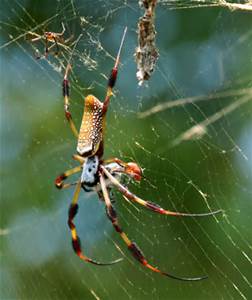
by Rick O'Connor | Aug 7, 2015
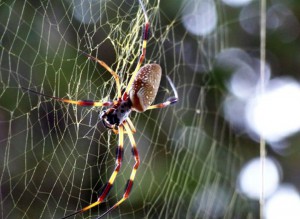
The elongated body of the Golden Orb Weaver. Photo: Molly O’Connor
TELL ME NO! Please tell me these huge spiders are not a part of our summer. People are afraid snakes… that’s a given – but there are just as many afraid of spiders. Honestly, after years of leading field hikes into the north Florida environment, when we encounter a spider web on the trail I have heard more screams from the boys than from the girls. But most are afraid and there nothing is more terrorizing than the huge, almost hand-size, Golden Orb Weaver (or banana spider).
The Golden Orb Weaver is one of 180 species of orb weavers from around the world; one from Australia is large enough to feed on small birds. The local species is Nephila clavipes and is found throughout the southeastern United States; in the warmer months it may reach as far north as New England. Female Orb Weavers are the really big ones you find on the webs. Their body lengths can reach 2” (not including the extended legs) and the males are much smaller at 0.02”. They have long inward pointing legs with hair-like tuffs at the joints. These are very useful in web building. They have the typical “red/yellow/black” coloration of a venomous animal and their mimics; but N. clavipes is no mimic… though mild, they do have venom. There is another orb weaver spider that is large a constructs large webs. This is the Black and Yellow Argiope (Agriope aurantia). One way to distinguish this spider from the Golden Orb is the “zig-zag” pattern it adds to its’ web near the center (where the spider spends a lot of its time).
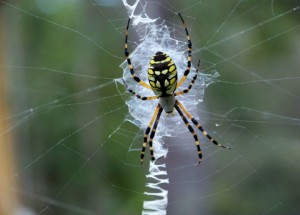
The zig-zag pattern of the Black and Yellow Argiope spider helps to distinguish from the Golden Orb. Photo: Molly O’Connor
The name “Golden Orb” does not come from their body coloration but from the color of the silk produced for their webs. It is believed that the yellow/golden color of this silk makes it difficult for others to see in open sunny areas. Many hikers can attest to this… they are hard to see, until you become entangled… then become aware the large spider is very close and heading your way… then the scream. N. clavipes can actually adjust the hue of yellow in the silk to match the sunlight conditions where it is building its web. It is amazing to see how quickly they replace their large webs, over 3 feet in diameter, after they have been removed by people. Actually they mend and move their webs regularly. They tend to build them off ground, at eye level to the tree tops, in open areas near a line of trees. I have actually seen one build the web across a dirt road between two stands of pines as if it were going to try and capture a truck! Though species of Orb Weavers feed on small birds and snakes, N. clavipes prefers flying insects. They do not wrap their prey in silk for later feeding, as many spiders do, but rather consume them almost immediately. This may be because of a small slivery spider called Argyrodes. This spider feeds on the captured food of other spiders. N. clavipes feeding may be an adaptation to combat this kleptoparasitic spider. Another interesting behavior I have noticed is when the heavy rains come. I have noticed the web remains but the spiders leave. I am not sure where they go, most likely a hiding spot nearby, but they do leave.
The fear of spiders is most likely similar to the fear of snakes… they are venomous. Venom is used to kill prey and many times is not strong enough to kill humans, but the fact that some species can kill makes folks a bit nervous. Despite local tales that say otherwise, the venom of N. clavipes is mild. It is a neurotoxin, which can be potent, but the bite from this spider is not lethal. The typical response is pain and redness at the site of the bite, blisters may form, but it is actually less potent than a bee sting.
Like many other species of spiders, the Golden Orb Weaver is a beneficial backyard creature consuming hundreds of biting (in some cases disease carrying) insects. The large webs can be a nuisance around backyard patios and swimming pools but they can easily be moved to other locations with a rake or broom. We have many of them in our yard, one out of my office window, and enjoy watching them work. They are good panhandle neighbors.
For more information on these beneficial creatures visit:
http://okeechobee.ifas.ufl.edu/News%20columns/Orbweaver.spiders.htm
http://edis.ifas.ufl.edu/in017
http://edis.ifas.ufl.edu/in467
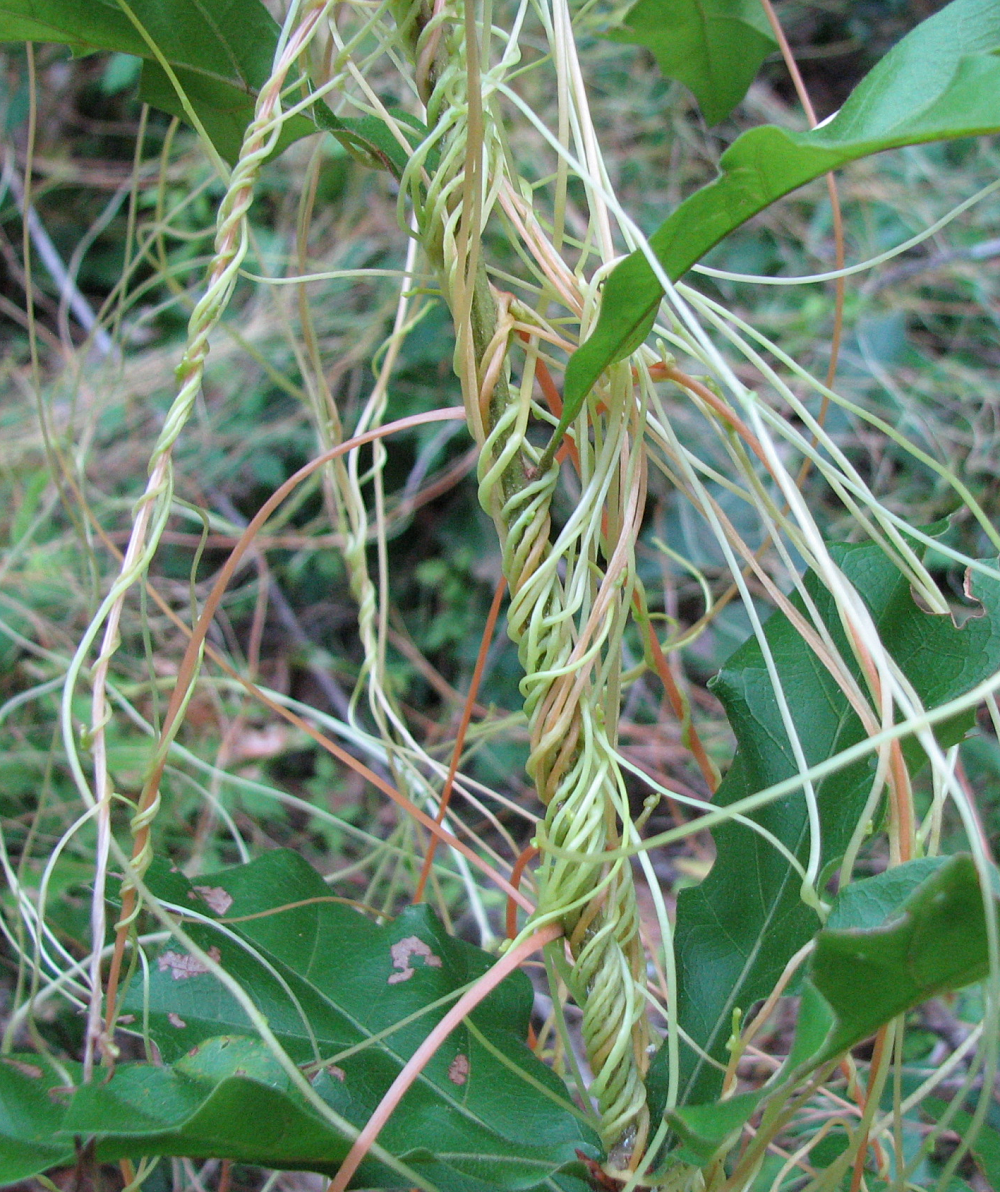
by | Jul 10, 2015
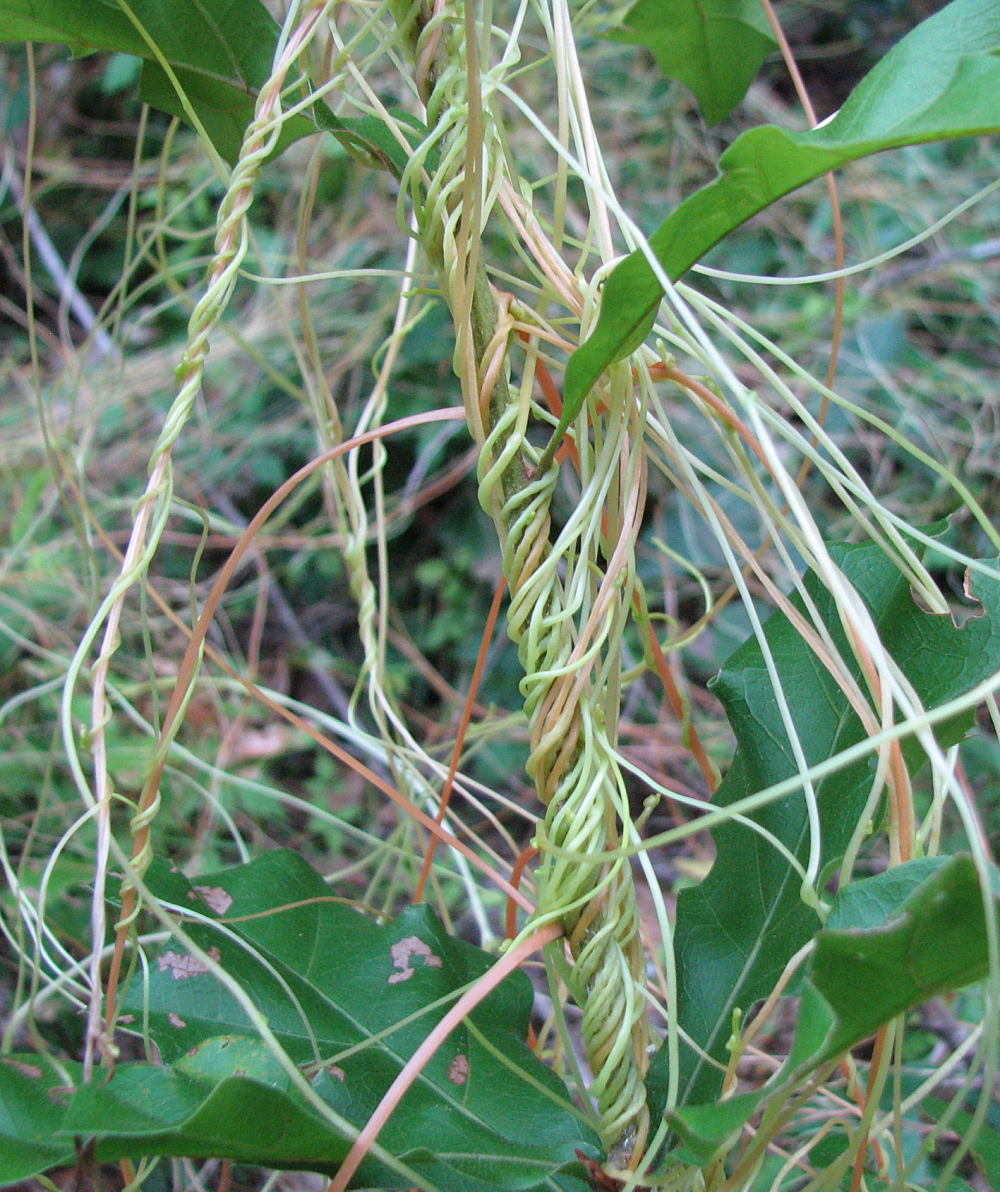
Dodder vines covering an oak seedling. The vines always wrap counterclockwise.
Photo Credit: Jed Dillard
Vampires of all types and genetic modifications are hot topics these days, and a common, but uncommon looking and acting Florida weed may have combined the two subjects. Dodder, a native invasive, parasitic plant, reproduces by seed but does not have enough leaves or chlorophyll to feed itself. Its thin, golden vines and tendrils must attach to a host plant in the seven to ten days it takes the plant to exhaust the carbohydrates in its small seed. Once dodder attaches to a plant, it connects to the inside of the host using small structures called haustoria which press into the stem and begin to draw nutrients from the host. At this point the dodder roots atrophy.
Single dodder plants are not a big issue, but once enough plants build up in an area large mats of vines can reduce growth and vitality of the host. (See photo) Frequently, the pest has reached this stage before it’s noticed, leaving the problem of treating a rootless, nearly leafless plant that is wrapped around a more desirable plant. Not only are the typical routes of herbicidal entry minimized, the hosts are at as much risk as the pest. Hand removal may be practical in small outbreaks, but the plant can reemerge from any small piece left attached to the host. In most cases, the solution is to destroy the host and the dodder and apply a pre-emergent herbicide to stop germination from any seeds remaining in the soil.
What about the GMO angle?
Work published last year in the journal Science by Jim Westwood of Virginia Tech reveals the dodder plant exchanges messenger RNA with tomato and Arabidopsis plants when it extracts the juices from the host plant. Scientists speculate this exchange of genetic material makes the host plant less resistant to attack by the parasite and that this holds promise for learning more about controlling other parasitic plants.
If plants are exchanging messenger RNA, a critical part of protein and gene synthesis, what other genetic exchanges are occurring naturally without our knowledge? Scientific progress hinges on unpredictable events and sources. Learning more from a “vampire weed” that has no easy means of control may be one of those.
To see the dodder plant go from seed to golden mat, watch this time lapse video Virginia Tech has posted on Vimeo. http://www.vtnews.vt.edu/articles/2014/08/081514-cals-talkingplants.html
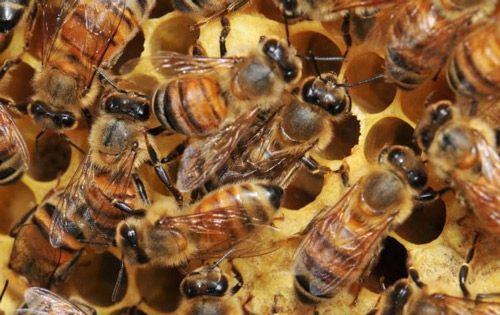
by Sheila Dunning | May 1, 2015
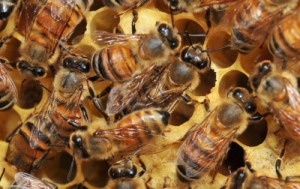
European Honey Bees
Photo: Ashley N. Mortensen; University of Florida
Bees have been disappearing at an alarming rate and continue to vanish without a trace. Why should anyone care? Well, they matter a lot more than most people think. Bees are the overwhelmingly dominant pollinator for most food crops. Native bees in the United States are responsible for pollinating over $15 billion worth of agricultural commodities annually. However, native bee populations are in decline due to habitat loss. At the same time, managed colonies of European honey bees have suffered a 50% decline over the past few decades. Numerous other pollinating insects are facing the same fate.
As the spring planting season is upon us, it’s exciting to think about all the wonderful produce we will have this summer. But, without pollinators many of these crops would not be available. The majority of fruit and vegetable food sources we eat are dependent on insect pollinators. One of every three bites of food Americans consume comes from a plant visited by bees or other pollinators.
As declining numbers of farmers work to meet the needs of an increasing population, they are forced to make choices on alternative to chemicals for pest control. “Good bug blends” of flowers can help attract pollinators as well as beneficial insects that suppress harmful pests. Establishment of these meadows can be done on a small or large scale and in any habitat. One approach to “bringing back the pollinators” is to intercrop with blooming plants that attract insects. Selecting a diversity of plants with different flower sizes, shapes and colors, as well as various plant heights and growth habits, will encourage the greatest numbers of pollinators. It is important to provide a continuous source of pollen and nectar throughout the growing season. At minimum, strive for three species to be blooming at any one time; the greater the diversity the better.
To enhance the garden, choose flowering plants that also provide shelter for beneficial insects. Many companion plants are suitable habitat for predators and parasitoids. Research in Florida has demonstrated that predatory minute pirate bugs can build to high numbers in sunflowers. The favorite food of minute pirate bugs is Western flower thrips. So, planting sunflowers on the perimeter of vegetable crops, such as peppers, can greatly reduce the damage caused by the thrips. Similar results were found with the planting of sorghum to attract beneficial mites and intercropping with buckwheat to house syrphid flies and parasitoid wasps. The garden vegetables experienced fewer spider mite, whitefly and aphid problems. Crimson clover, Hairy vetch and cosmos are other annual seed crops that can aid in attracting pollinators and harboring beneficial insects.
Insectary meadows can be created in the landscape and along roadways, not just in the garden. For more permanently planted areas, native wildflowers, grasses and woody plants serve as larval host plants for butterflies, and also provide nesting and overwintering sites for bumble bees, predacious beetles and other beneficial insects. Native perennial wildflowers such as blanketflower, tickseed, black-eyed Susan, partridge pea, narrowleaf sunflower, milkweed, beebalm, goldenrod and silkgrass can be installed in the spring as potted plants or seeded in the fall. Seeds require exposure to cold temperatures and damp conditions before germination can occur. In Florida, the best time is November to February.
Though grasses do not offer nectar or high-quality pollen, it is often useful to include at least one native bunch grass or sedge. Short, clump-forming grasses are preferable to large, spreading grasses. Hedgerow planting of woody species is a way to provide winter-blooming plants vital for supporting pollinators. Woody plants and grasses provide more than forage for pollinators, as many native bee species nest in the stems of plants or in the undisturbed ground underneath plantings. Suitable grasses include: beaked panicgrass, purple lovegrass, Muhly grass, broomsedge,little bluestem, wiregrass and toothache grass. Favored woody species that make good “beetle banks” include: fetterbush, American beautyberry, saw palmetto, Chickasaw plum, red maple, sparkleberry, Dahoon holly, redbud, blackgum, magnolia, buttonwood and sourwood.
Regardless of whether the objective is to establish herbaceous or woody vegetation, the time and effort spent on eradicating undesirable plants prior to planting will result in higher success rates in establishing the targeted plant community. Choose level, open sites that receive full sunlight and have limited weed populations. If perennial weeds are a problem, the use of herbicides that have no soil residual (e.g. glyphosate) may be necessary.
For more information on establishing planting for pollinators visit: www.xerces.org/pollinator.
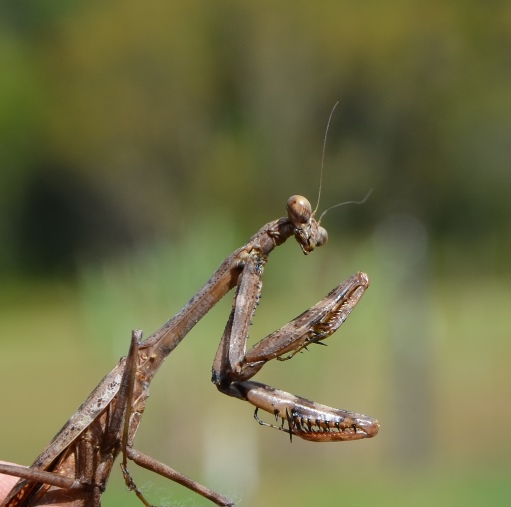
by Les Harrison | Mar 20, 2015

The preying mantis is well equipped to thin the population of destructive insects.
The last two years have been kind to the insect population in north Florida, and 2015 appears to be continuing the trend. The weather has provided enough rain for those bugs which depend on the generous supply of foliage and the temperatures are returning to an agreeable range for population growth.
Stink bugs, leaf-footed bugs, grasshoppers, all sizes of caterpillars and many more are hatching bent on enjoying the lush and plentiful dining selections. Homeowners and gardeners may soon be plagued by the sudden appearance of hordes of hungry pest which are eyeing the menu choices at a residence’s landscape.
Fortunately, nature has a way of equalizing all situations when left to its own devices. With the increase of the plant eaters comes those insects which restrain their population explosions.
One of the most easily recognized predator insects is the praying mantis. This beneficial insect is actually a family with multiple members, some of which have been introduced to Florida.
While there are over 2400 mantis members worldwide, Florida is home to eleven natives. Two of those have been introduced from other regions, but are not considered invasive.
Mantises are thought to have evolved during the Cretaceous period about 100 million years ago, possibly from a predatory cockroach with similar front legs. Their closest surviving insect relatives are cockroaches and termites, both of which they will consume if given the opportunity.
Like many insects, the mantis is equipped with a tough, durable exoskeleton which provides a basis for successful close quarter combat and meal procurement. These hunters have three other advantages which create a severe vulnerability in their prey’s defense and potential for surviving a mantis encounter.
The mantis is an ambush predator which will lay in wait for the victim/meal to deliver itself. The mantis has the instinctive ability to identify and hide in areas with high amounts of prey traffic.
This insect is a master at stealth and camouflage. The creature’s coloration and linear shape allow it to blend into the many natural settings.
To complement this facility to conceal itself in plain sight, the mantis can hold perfectly still and patiently wait for the oblivious animal to bumble into sticking range. At that precise moment, the mantis is a blur of lethal motion.
The mantis’ forelimbs are a set of deadly spiked vices used to immobilize and secure its target. It extends these spiny levers forward in a raised position which appears as though it is in prayer, hence its name.
The intended kill technique is to impale and restrain the victim with a single stroke of the forelimbs while holding the victim securely to the mantis’ body. On occasion the attempt fails and the mantis has to apply a more direct approach.
This insect’s beak is designed for slicing and tearing its victims flesh. The jaws provide the power to effectively employ this means to its meal’s head.
Depending on its stage of life, the mantis will eat a wide variety of creatures. Early stage mantises will eat little flies and other tiny insect (including its siblings), but at maturity they will take on small reptiles and amphibians along with a variety of destructive insects.
Despite its vicious nature, the praying mantis is the soon-to-emerge answer to many gardeners’ prayers.
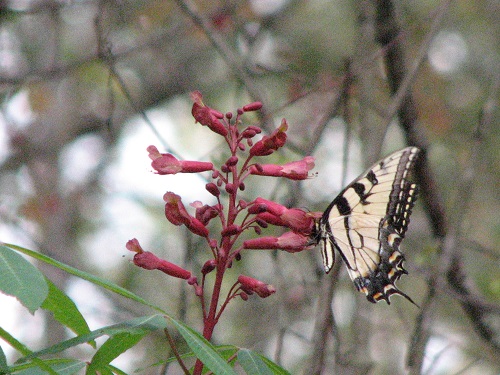
by | Mar 6, 2015

Swallowtail Butterfly Feeding on a native Buckeye. Buckeyes also attract hummingbirds.
Photo Credit: Jed Dillard
Honey bees are quite the buzz these days. Reports of population declines and the importance of their role in pollination have caught the country’s attention. The Northwest District IFAS Beekeepers’ classes have grown by leaps and bounds over the years. Many folks have decided to keep bees for the first time and even those who do not start their own hives are itching to know more about how to help these industrious insects.
As important as the European honeybee is to our agriculture, there are many species of native pollinators that were here when the first European bees arrived with the settlers from England and Spain. Many of our crops were also introduced, but when the Native Americans began growing squash and pumpkins, the honeybees were not around. Many native plants we treasure in landscapes and natural lands are also dependent on these pollinators.
Butterflies may be our most familiar pollinator after honeybees, and growing a butterfly garden is a great way to enjoy these colorful visitors. However, there are many other native insect pollinators. Moths may come to mind next, but native bees are the unknown stars here.
There are over 300 species of native bees in Florida. Some are conspicuous like bumble bees and some are rarely noticed because of their small size. These species are also economically important. Bumble bees are preferred in vegetable greenhouses, because they are more active than honey bees, and are also major pollinators of cotton.
As we increase our interest in native plants, it’s important to preserve and enhance native pollinators. Choosing native plants is just the first step. Many native annuals can reseed themselves if managed properly, and assuring there are appropriate pollinators on hand is one of the key steps in that. If you’ve planted to attract wildlife, you’ll want to know which pollinators will ensure fruit is produced.
As you attract more native pollinators, you’ll have a more vibrant native plant community. As you have a more vibrant native plant community, you’ll support a larger and more diverse native pollinator population, and that’s some more buzz the world needs to catch.
More information on butterfly gardening is available from the University of Florida . UF information on attracting and supporting native bees is available at http://entnemdept.ifas.ufl.edu/honeybee/nbns.shtml, and there is a great citizen science project on native bees (Teachers, youth leaders, parents have you read this far?) “The Native Buzz” at http://entomology.ifas.ufl.edu/ellis/nativebuzz/. The Xerces Society for invertebrate preservation also has informational resources available at http://www.xerces.org/.
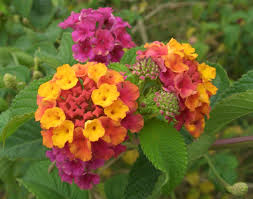
by Sheila Dunning | Feb 20, 2015
It’s Growing So Well It Must Be A Good Plant. Right?

Lantana camera
You know that plant in the corner of the yard that seems to be taking over? It’s the one that your friend “passed along” because they had plenty of them and wanted to share. After all, it grows so well. How can you go wrong? The odds are that vigorous plant is a non-native species. The majority of what is sold in nurseries are introduced from a foreign country and developed for their uniqueness.
The problem is that many of the plants brought into the United States arrive without their natural enemies. Under the long, warm growing season found in Florida, these non-native plants become the dominant plant in an area and manage to out-compete the native plants. When this happens, these introduced plants get labeled as an “invasive species”.

Nandina domestica
If you want to learn more about your friend’s ”passalong” plant be sure to visit the Assessment of Nonnative Plants in Florida’s Natural Areas website and database at http://assessment.ifas.ufl.edu/.
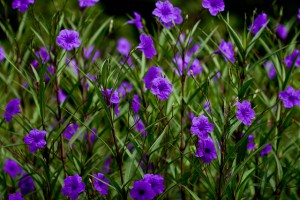
Ruellia brittoniana Mexican Petunia












